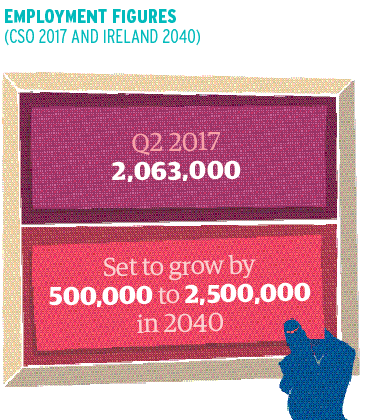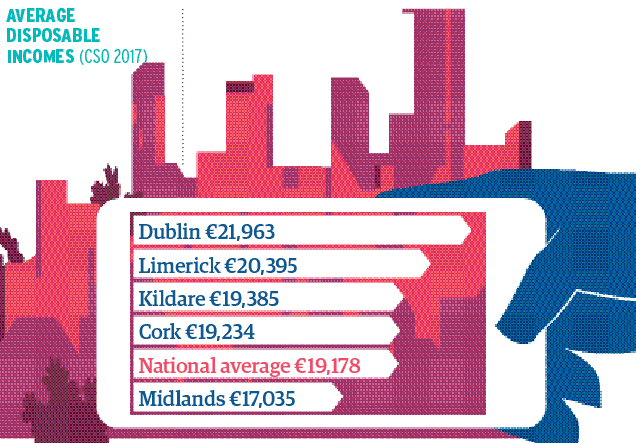Questions are being raised about the potential construction plans for a new city in Ireland to alleviate the pressure on Dublin. Is it reasonable or ridiculous?
With the population of Ireland set to grow by 750,000 by 2040 and the Greater Dublin Area as a whole currently catering for 1.8m of the Irish population (roughly 38%), calls are being made for the development of a new city to take the pressure off of the nation’s capital.

Many factors are being taken into account when debating the need for a new urban centre: the underutilisation of other city centres, lack of housing, and 2040 estimates outlining future housing construction in the Dublin hinterland and Greater Dublin Area (75%). Post-primary numbers are set to rise to around 400,000, national employment figures jump by 25% to 2.5m, and nearly half of Ireland’s economic activity is expected to occur around the Dublin area.

The National Planning Framework is a key governmental plan that could play a significant role if the likes of Cork are to leap forward as potential competitors to Dublin’s large-scale economic activity.
On July 19th the government took to Castletown House in Celbridge, Co. Kildare for a brainstorming session whereby Minister for Finance Paschal Donohoe addressed his governmental colleagues on the 10-year capital investment plan running from 2017 to 2028. This is where Minister for Housing Eoghan Murphy set out the National Planning Framework known as Ireland 2040.
Questions are plentiful. How much potential is there for a new city? How will it be implemented if there is to be one? Are current locations undervalued and underused? Is it feasible? How will it be financed? How will it work out for the growing population of Ireland?
POTENTIAL
Locations under discussion revolve around the midlands and the north-west. With motorways connecting Cork to Dublin and Limerick to Naas, for example, plenty of options are available for commuter journeys between the south, the midlands and the capital. This is also correlated with rising property sales in the middle of the country, with locations surrounding the Dublin hinterland seeing growth thanks to more business opportunities and an increased affordability of housing.
The Sligo area has also been tipped as a possibility due to its close proximity to Galway and the M6 motorway connection to Dublin. A desire to eliminate the stereotypical view of a barren west of Ireland is on the radar for the government and the associated regional areas.
Concepts such as this aren’t new by any stretch of the imagination. Just 50 years ago, Milton Keynes, a suburb 45 miles north-west of London, was constructed to relieve pressure from the centre of the British capital. This suburb has since integrated into the sociopolitical landscape seamlessly since its inception half a century ago.
All of this combined creates the beginnings of discussions for a new city. But how will it be implemented? What will it mean for populations, businesses, constituencies and transport?
INCENTIVE
According to the Central Statistics Office (CSO) 2016 Census figures, the midlands has a population of 292,301 and caters for 9.5% of the total area of the state (around 6,500km2).
With Dublin naturally being the most affluent location, would there be an incentive for people to vacate the capital? 2014 figures show disposable income in Dublin coming in at €21,963 compared with the national average of €19,178. But counties in the midlands area such as Laois, Longford, Offaly and Westmeath are worse off in this regard, with an average disposable income of €17,035, 11% below the national average. Is this really a draw for a potential new-look urban area? If the new city happens, will it bring more affluence to the chosen location?

The second, third and fourth most prosperous counties in terms of disposable income are Limerick (€20,395), Kildare (€19,385) and Cork (€19,234), respectively. Limerick and Cork are already established economic centres, and Kildare is close to the capital. Why aren’t these being driven forward as potential candidates for restructuring and building?
MAJOR CITY USAGE
Ireland’s main commercial hubs seem to be underused and may be undervalued; Cork county’s population of 542,196 (2016) sees 102,139 out of the city’s 125,657 working in the city centre.
Limerick has a population of roughly 100,000 in the city centre/suburbs and 42% of the population is below the age of 30. Why isn’t this youthful potential workforce not in more demand, especially with the transport infrastructure networks that surround the Treaty County now? In addition, the University of Limerick’s growing reputation should make it a hotspot for potential employment development. This doesn’t seem to be the case, as of 79 unemployment blackspots in Ireland, eight of the top ten are in Limerick.
Waterford, marketed as part of the ‘Sunny South East’, is almost forgotten among the other behemoths on the island and possesses an over 100,000-strong population base (113,795), of which more than half inhabit the city of Waterford and its suburbs. But according to 2016 Census figures, Waterford holds the highest unemployment rate in the country among cities (18.8%).
Galway’s population of over a quarter of a million (258,552) sees the biggest county in the west boast a thriving university population and youthful scene; 25% of the city centre’s population are students who view themselves as having a high level of education (2015 figures). Perhaps these were factors in last year’s announcement of Galway as European Capital of Culture for 2020 (alongside Croatia’s Rijeka).
With so much potential in our already-established urban centres, we’re not seeing enough worthwhile results outside of Dublin. Demographics in the third-level education age brackets are sticking to the likes of Cork, Limerick and Galway for their education but don’t seem to be too enamoured with post-education opportunities afterwards, causing an influx of post-third-level twenty-somethings into the capital.
SHOULD THE NEW CITY BE IMPLEMENTED?
Let’s not forget, Dublin isn’t London – at least not yet, even with Brexit uncertainty being advantageous for the capital to some extent as divisions of major organisations such as Bank of America, Lloyd’s of London and JP Morgan favour Dublin for their new EU HQs.
We’re restricted by simply being an island and by our land mass: we’re just not big enough to take on the demands of a world metropolis. But this doesn’t mean starting from scratch with a brand-new urban centre will shake off Dublin’s (future) woes.
Why aren’t we seeing our existing urban centres’ frameworks being brought to the fore? Is there still an element of Dublin being seen as the only prosperous location on the island?
The Irish tech scene is a thriving sector. Cork, as the second-largest city in the country, boasts a buoyant start-up environment as well as some of the biggest players in the game such as Apple and Amazon, the former of which looks to a host of foreign workers to bridge language barriers when conversing with foreign customers and clients.
With some of the biggest tech companies in the world sitting on Leeside, the fact that the government is mooting the development of a whole new city to alleviate traffic from the Dublin area seems a waste of our already developed metropolitan areas’ resources.
With Limerick and Cork among the highest average earners in terms of disposable income in the country (second and fourth, respectively), and given their proximity to each other, a potential partnership and combination could be extremely beneficial to economic growth south of the country.
With both counties’ populations combined, one could count nearly three quarters of a million people (737,371). The two areas also can take pride in having two of the top universities in the country (UCC and UL) as well as two major airports (Cork and Shannon). Cork Harbour is also said to be one of the largest natural harbours in the world.
‘Work on what we have’ seems like the simple answer to me. For a nation our size the potential to provide for the people we already have outside of Dublin is there for us. The rest of the country needs recognition, something that will come with further promotion of Irish cities such as the European Capital of Culture year and ministers’ communications with world leaders and businesses when abroad promoting Ireland.
PROS:
Similar new-city developments abroad have worked, such as Milton Keynes north-west of London. Transport links outside of Dublin have improved dramatically over the past two decades, creating connections between the main urban centres in Ireland. Third-level institutes independent of the major universities and with young student communities could see a new city as beneficial.
CONS:
The average disposable income figures around the midlands and north-west are not an incentive for people to move away from the capital for work. Our established urban centres are under-utilised and undervalued even with excellent infrastructure and education facilities already in place.
VERDICT:
My opinion? A ‘new city’ should not go ahead. Our educational and transport structures along with young populations in the likes of Limerick and Galway possess enough potential as it is. We should be looking to develop this resource and encourage business activity. A link between Cork and Limerick and the further development of Galway would do wonders to relieve future pressure from Dublin. Waterford’s unemployment rate among cities is a worry and should be addressed to make it a more viable option.







